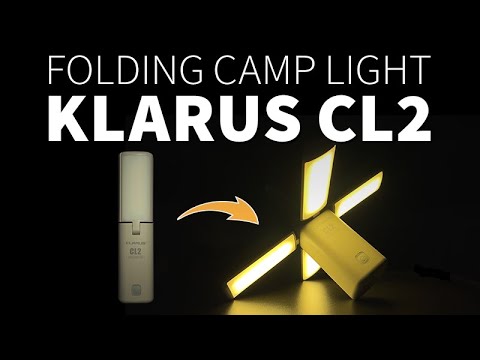Klarus CL2 Review: Lanterns have caused quite a stir in the flashlight community in recent years. Olight has a few versions, including a fresh new model, Lumintop has an excellent offering, and no one can forget the BLF-LT1 with all of its available variations. If you explore a little deeper, you will undoubtedly discover that a new lantern is launched each month. It’s easy to get lost in the jumble of black metal cylinders that emit light in a 360-degree arrangement. Consider making the light panels white and plastic, and allowing you to direct them independently by indexing each side. Most importantly, they also kept a genuine flashlight in the housing.
Package quality.
The Klarus CL2 arrived in a large white, printed, thick cardboard box. I was curious how much extra space would be in the packing once I opened it. To my astonishment, there was hardly no spare room. The actual light is much larger than I expected, and it came packaged in a plush, flocked bag beside an accessory bundle. I suppose “waste not, want not” applies here. The charging cord, handbook, and iPhone adaptor were all jammed inside the accessory package.
The full list of contents included are:
- Klarus CL2
- Carrying pouch
- Charging cable
- iPhone charging cable adaptor
- User manual
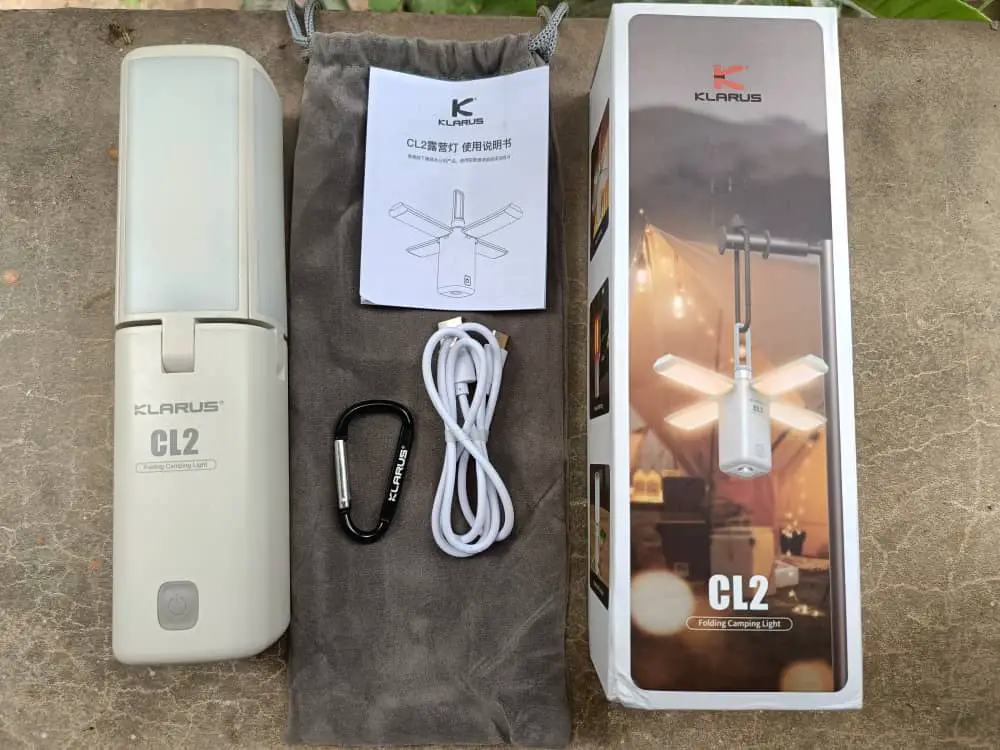
Klarus CL2 specifications
| Brand & Model | Klarus CL2 |
|---|---|
| Flashlight category | Lantern |
| LED | N/A (cool white, warm white and red LEDs) |
| Max. output | 750 lumens |
| Max. beam distance | – |
| Max. beam intensity | 1712 cd |
| Battery config. | Built-in battery pack |
| Onboard charging | USB-C Onboard |
| Modes | 4 |
| Blinkies | Strobe and SOS |
| Waterproof | IPX5 |
| Review publication date | December 2022 |
Flashlight in use
When you take the CL2 out of the package, you’ll see that it’s not exactly like the Sofirn, Lumintop, or other lanterns you’ve seen recently. This isn’t a black lump of aluminum. It is not any other exotic metal. This is plastic. It’s a light gray color. The CL2 is somewhat more than 5.5cm square, but with a soft radius at each corner. Standing tall at nearly 22cm, there is plenty of light here.
The entire top half is made up of four separately folding lantern panels, which allow you to divert or block light in any direction other than straight up. It will tail stand all day but will not shoot light upwards at all. When these are folded down, you can hear the loud clicks of a ball detent system, which helps maintain them indexed as you’ve specified.
Folding them down reveals a silicon hanging loop and ¼-20 tripod thread in the center. The silicon is pleasant to the touch, but thick enough to feel robust. There is no pocket clip and it feels far too wide to fit in a pocket, so these are the only ways to support it, aside from setting it on a table. If you choose to carry it by hand, you won’t have to worry about the cold feel of aluminum because the plastic body remains warmer than metal in the cold, where I tested it.
The radiused edges also make it easier to handle. It features an e-switch near the bottom. The switch cover is constructed from the same material as the charging port cover on the other side. It would have been wonderful to have a means to illuminate the switch so that it was easy to operate in the dark. On the bottom of the lamp, there is a small (17mm) lens for a flashlight that may be engaged; while the ergonomics are not ideal, it can be easily held to use if necessary.
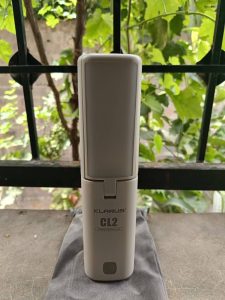

Build Quality, and Warranty
The build quality is rather good. Because it is composed of ABS plastic, you will not get the same machining tolerances as aluminum or any of the exotic metals used in modern flashlight manufacturing, but everything is sturdy and there are no creaks to speak of.
The CL2’s hue is a light gray that lends itself to being labeled white in certain lighting conditions. The hinges for the folding lantern panels can twist slightly but feel solid. When closed, they are kept together by magnets in each panel. After taking the images for this review, I performed a drop test to ensure the durability of the plastic, which passed with flying colors. After several drops, the sole casualty is one diffusion lens that slipped out but was quickly snapped back in. My guess? It was the panel I had removed previously to get an interior image of the lantern panel.
Now, my attempts at destruction were intentional, and no problems or damage resulted from that testing. If the lantern you purchase has any flaws, Klarus offers a one-year warranty on the CL2. You can contact them through their website, and everything will be resolved. However, there were a few issues with the quality of my unit. One is the real operating button. It would record approximately 95% of the clicks I threw at it. I would have had somewhat greater success if I had positioned my button pressing finger slightly to the top of the button instead. Every time this happened, I just turned it off and used more careful presses the next time. The second feature, which, regrettably, is one that I would use all the time, is the tripod mount. When I inserted the tripod to hold the light, it kept spinning. I removed a screw to investigate the problem, and it turns out there is a 1.5mmx1.5mm plastic nub/keyway that prevents the tripod mount from spinning. If there is any force, it shears right away and does not hold up well after that. Now, because this unit is plastic, I am simply going to epoxy it to use it to its maximum potential.

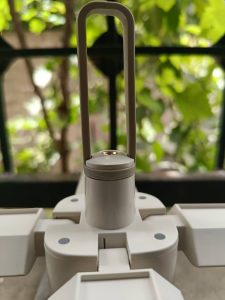

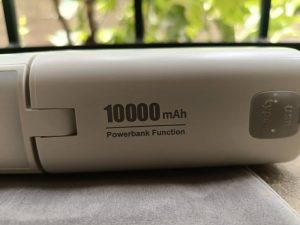
Reflector, LED, Lens, Bezel, and Beam
There will be two sections to this. Let’s talk about the main event first: the folding lantern panels. Each of the four has an own set of LEDs for the warm and cold modes. They must use more LEDs to achieve the same impact because the diffusion is quite near to the emitters themselves. There are twenty-four LEDs for each setting. and it only covers one mode. There are 24 for warm, and another 24 for cool. And there’s the red strobe, too, hehe. Yes, that also has ten more people jammed in there. That works out to 58 different emitters in a single panel, based on my calculations.
There are also four panels. Each lantern has 232 individual LEDs soldered to it. As an aside, each CL2 contains a total of 237 leds if you count the flashlight section and the battery indicators. That’s a lot, wow. The cool white emitters struck your eyeballs at 5350k, while the warm white emitters, which had no manufacturing temperature rating, came in at somewhat under 3000k. With the warm component coming in somewhat lower than the cool white, both are 70CRI Ra. The numbers were constant between low, medium, and high, therefore there was no tint shift.
Let’s go on to the flashlight itself. The single thrower at the base of the CL2 is surprisingly powerful for such a small light—one that I would have expected would have been an afterthought—given that it isn’t meant to be the main attraction. Although it is currently the brightest object in the world, it still has a respectable range for its small size at just 100 lumens. The light emerges in a rather prominent hotspot with a barely noticeable two-stage corona, thanks to a TIR reflector that appears to be rather deep for its size. There are two little rings floating around the center, giving it a slight spill, making it look almost like a halo. The light came in at about 6750k and looks the part too, appearing to almost lean into a blue light.
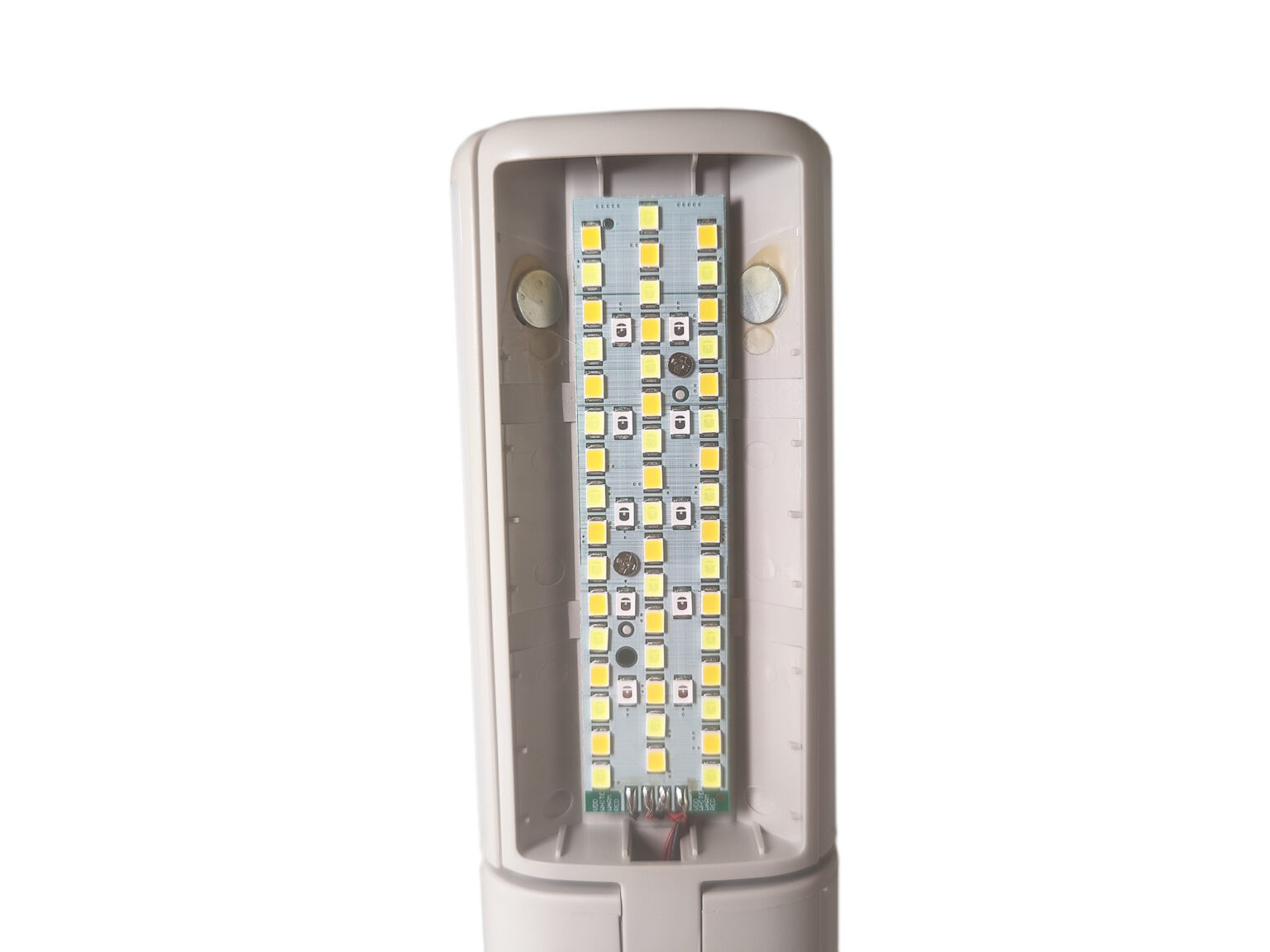
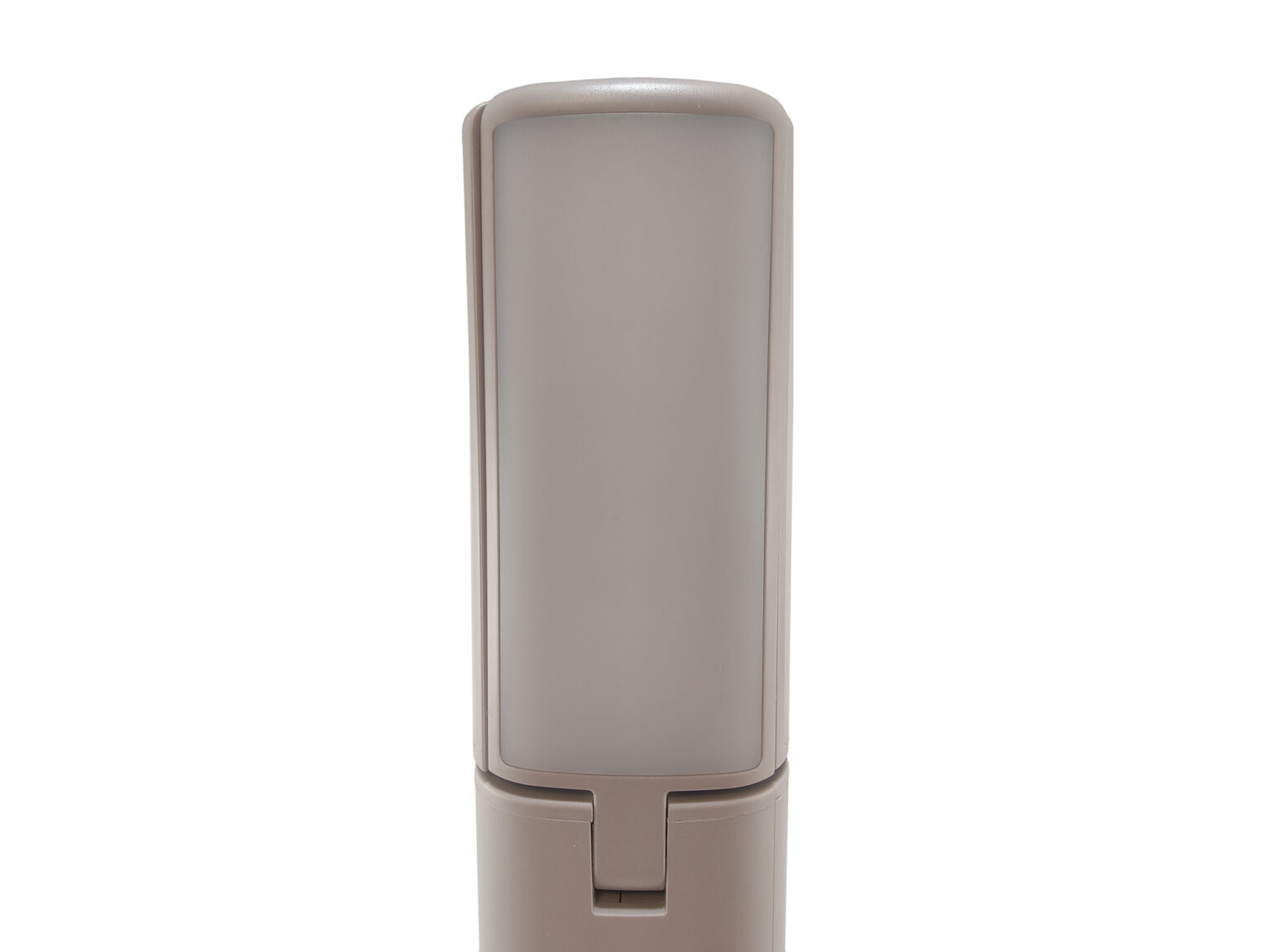
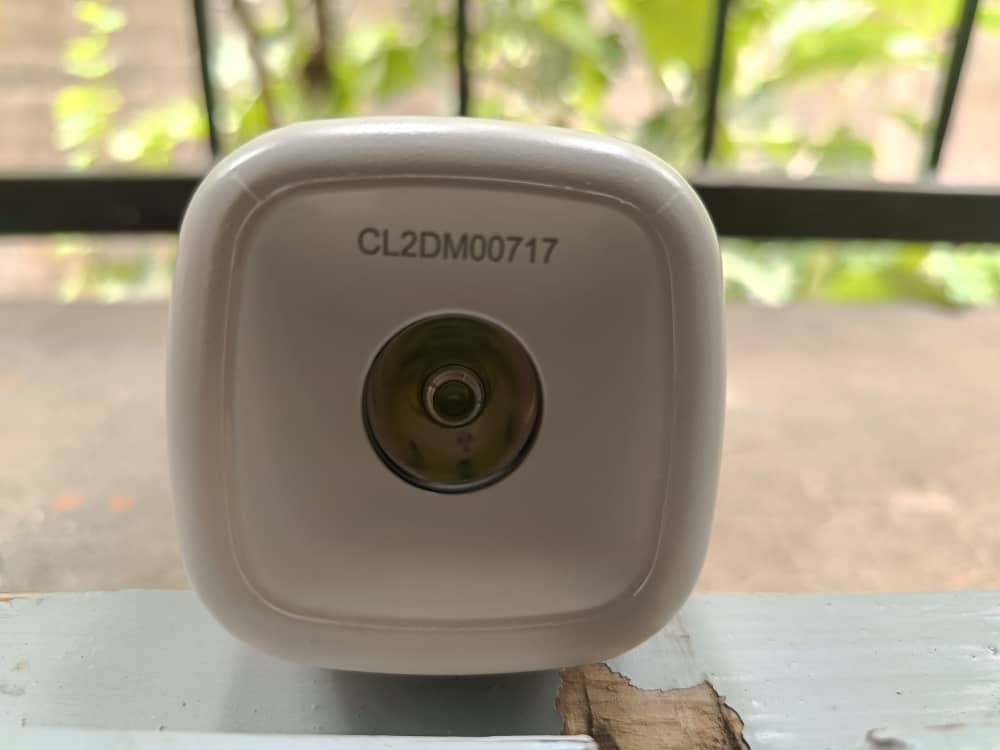
Dimensions:
| Klarus CL2 | Millimeters | Inches |
|---|---|---|
| Length | 222 mm | 8.7 in |
| Head diameter | 56 mm | 2.2 in |
| Body diameter | 56 mm | 2.2 in |
Dimensions are rounded to the nearest millimeter, and to the nearest tenth of an Inch.
Weight:
| Klarus CL2 weight | Weight in grams | Weight in oz |
|---|---|---|
| With battery | 411 g | 14.5 oz |
Weight is rounded to the nearest gram, and to the nearest tenth of an Oz.
Driver & User Interface:
The Klarus CL2’s UI interface reminds me of a more sophisticated version of the typical “zoomie” kind. Pressing the button will activate the “warm low” setting, followed by “warm medium”, “warm high”, and “cool high”. However, if you stop to smell the roses and wait more than three seconds, any click will turn the light off. It can be annoying if you want to increase the brightness but have already set the lamp to a different mode. To activate the flashlight, strobe, or SOS, follow the same steps as before, but this time hold the power button. This will initiate the cycle of your “secondary configurations”. It’s odd to have a flashlight in your secondary modes, but it underlines that this is really a lantern. What are the other options? Those are a plus.
Available modes: Warm Low, Warm Medium, Warm High, Cold High, Flashlight
Available blinky modes: Red Strobe, SOS
From OFF:
- Press and hold: Go into secondary configuration (Flashlight, Strobe and SOS)
- Single click: Turn the unit on
From ON:
- Press and hold: Go into secondary configuration (Flashlight, Strobe and SOS)
- 1 click (within 3 seconds): Rotate between modes in configuration
- 1 click (after 3 seconds) Shut the light off
Mode memory:
- No memory mode. Must cycle through all settings.
Low voltage warning:
- Just the battery indicator
Strobe/blinkies
- Strobe and SOS. Press and hold the power button from off, this will activate the flashlight. From here, a single press will move to a red strobe and then an SOS from the flashlight.
Lock-out mode:
- No lockout mode present
PWM
- No PWM present
Batteries & Charging
The Klarus CL2 includes a USB-C charger as well as a powerbank function. Now, I’m not sure about the cell configuration in this specific light, but given that it’s rated at 10000mah, I’d imagine four 18650 cells. However, that is just guesswork.
What I can tell you without assurance is that the charge topped out at 2A (just as specified) and charged the light to full capacity in 5 hours and 18 minutes. Not bad. The charging port is a USB-C port that lies next to a full-size USB-A connector beneath a silicon cover. This is a press fit to keep out outside moisture. Underneath this lid are four small white LED indicators that show how full the battery is. Between full capacity and 76 percent, all four lights will be illuminated, with three lights for 75 to 51 percent, two for 50 to 26 percent, and one for 25 percent or below.
The full-size USB-A connector allows you to use a powerbank to charge your other items. This has an extra battery, so it’s wonderful that they’re offering you multiple options for using it. I tested the full-size USB-A port to charge my cell phone, and it worked fine. My USB meter showed that it maxed out at 1.9 amps but preferred to hover around 1.5.

Performance test
All measurements were acquired with a specially designed integrating sphere and an ExTech SDL400 datalogging lux meter. The known output of a light source (273lm Convoy S2+) was then used to calibrate my figures for accuracy. The built-in battery pack was completely charged before each performance test.
Lumen measurements (for each mode)
| Mode | Specified | turn on | 30 sec | 10 minutes |
|---|---|---|---|---|
| Warm Low | 30lm | 50lm | 49lm | 51lm |
| Warm Medium | 150lm | 219lm | 218lm | 219lm |
| Warm High | 750lm | 710lm | 690lm | 648lm |
| Cool High | 750lm | 718lm | 704lm | 666lm |
| Flashlight | 100lm | 113lm | 109lm | 104lm |
Battery Life: Runtime graphs
All modes were tested with the built-in battery fully charged (after the charging sequence stopped).

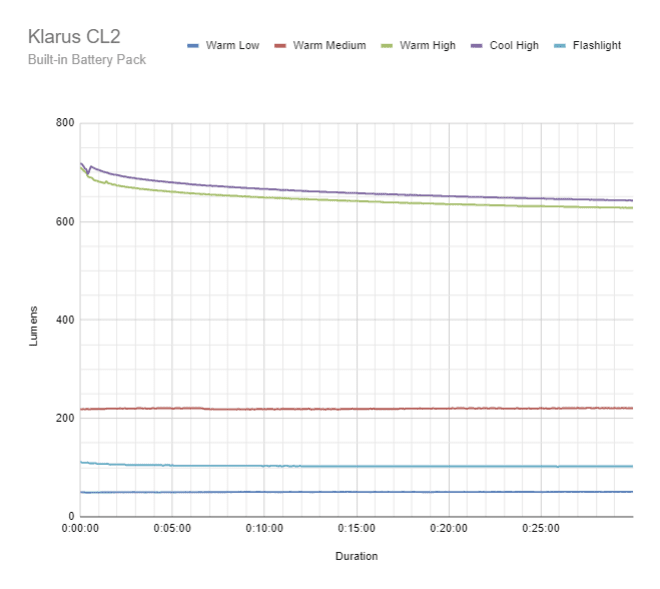
| Mode | Specified | Measured runtime ANSI | Time till shut off |
|---|---|---|---|
| Warm Low | 60h | 24h+ | 24h+ |
| Warm Medium | 12h | 17h 5min | 17h 5min |
| Warm High | 4h 45min | 5h 3min | 5h 3min |
| Cool High | 4h 45min | 4h 57min | 4h 57min |
| Flashlight | 18h | 24h+ | 24h+ |
Some of these modes performed virtually exactly as Klarus predicted. Others…not so much. The Warm Medium and flashlight runtimes exceeded the specifications. The driver continues to give enough juice to maintain a decent output level until it practically runs out. This explains why the ANSI runtimes were longer for some modes.
ANSI FL1 standards: The runtime is measured until the light’s output reduces to 10% of its starting value (30 seconds after turning on). This is not to say that the flashlight is no longer usable. The last column tells how long the light lasts before turning off. If there is a plus symbol, it indicates that the test was halted at that moment, but the light was still on. This occurs on sometimes, with specific drivers, firmware, or batteries.
Peak beam intensity and beam distance measurements
The Klarus CL2 was tested at 5 meters using the Opple Lightmaster Pro. There was an effort from further back, but the omnidirectional nature of a lantern reduced the light too much to obtain decent results.
| Mode | Specified | Candela measured | Meters | Yards |
|---|---|---|---|---|
| Warm Low | * | 32cd | 11m | 12yd |
| Warm Medium | * | 152cd | 25 | 27yd |
| Warm High | * | 464cd | 43m | 47yd |
| Cool High | * | 488cd | 44m | 48yd |
| Flashlight | 1712cd | 2548cd | 101m | 110yd |
*manufacturer specifications not provided
The lantern has no manufacturer specifications, which is fairly typical for a lantern, but I am really impressed with the figures I received. The flashlight mode seemed to exceed my expectations, although not by many kilometers, and I believe these figures.
Extra information: Peak beam distance, according to ANSI FL1 standards, is the calculated distance in meters at which the flashlight generates a light intensity of 0.25 lux. (0.25 lux represents the brightness of a full moon shining on an object). The columns ‘Meters’ and ‘Yards’ include rounded numbers.
photo-shots
Photos were taken with a Panasonic Lumix g7 at ISO 200 and shutter speed 1/60. Unfortunately, the tiny picture sensor does not perform well in low light conditions, but I tried to maintain consistency. Instead of beamshots, I attempted to capture some informative brightness shots of the output.
Lantern “glow” comparison of the following flashlights compared:
- Klarus CL2





At the end you can buy Klarus CL2 from its Official Website, you can use Code(15%OFF): Achraf Grini.
Disclaimer: This flashlight was sent to me for review at no cost by Klarus. I have not been paid to review, nor have I been holding back on problems or defects.


